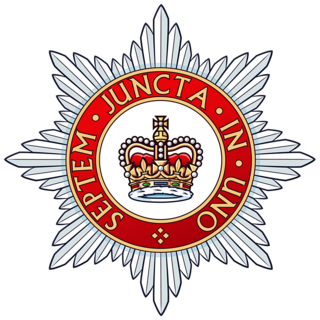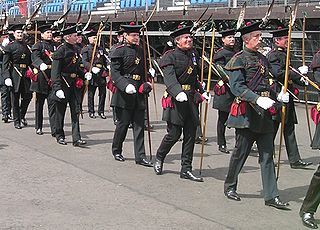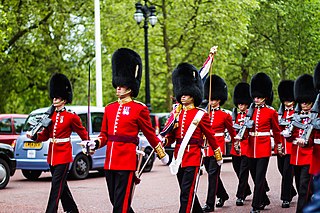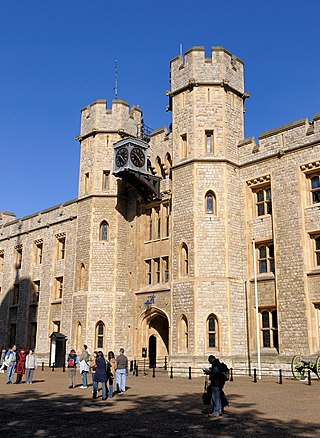
The Tower of London, officially His Majesty's Royal Palace and Fortress of the Tower of London, is a historic castle on the north bank of the River Thames in central London, England. It lies within the London Borough of Tower Hamlets, which is separated from the eastern edge of the square mile of the City of London by the open space known as Tower Hill. It was founded toward the end of 1066 as part of the Norman Conquest. The White Tower, which gives the entire castle its name, was built by William the Conqueror in 1078 and was a resented symbol of oppression, inflicted upon London by the new Norman ruling class. The castle was also used as a prison from 1100 until 1952, although that was not its primary purpose. A grand palace early in its history, it served as a royal residence. As a whole, the Tower is a complex of several buildings set within two concentric rings of defensive walls and a moat. There were several phases of expansion, mainly under kings Richard I, Henry III, and Edward I in the 12th and 13th centuries. The general layout established by the late 13th century remains despite later activity on the site.

The Yeomen of the Guard; or, The Merryman and His Maid, is a Savoy Opera, with music by Arthur Sullivan and libretto by W. S. Gilbert. It premiered at the Savoy Theatre on 3 October 1888 and ran for 423 performances. This was the eleventh collaboration of fourteen between Gilbert and Sullivan.

The King's Body Guard of the Yeomen of the Guard is a bodyguard of the British monarch. The oldest British military corps still in existence, it was created by King Henry VII in 1485 after the Battle of Bosworth Field.

Yeomanry is a designation used by a number of units and sub-units in the British Army Reserve which are descended from volunteer cavalry regiments that now serve in a variety of different roles.

The Household Division forms a part of the British Army's London District and is made up of five regiments of foot guards and two Household Cavalry regiments. The division is responsible for performing public duties and state ceremonies in London and Windsor. Such functions include the State Opening of Parliament, Trooping the Colour, and mounting the King's Guard.

Guard mounting, changing the guard, or the changing of the guard, is a formal ceremony in which sentries performing ceremonial guard duties at important institutions are relieved by a new batch of sentries. The ceremonies are often elaborate and precisely choreographed. They originated with peacetime and battlefield military drills introduced to enhance unit cohesion and effectiveness in the late 17th and early 18th centuries.
The Women's Royal Army Corps was the corps to which all women in the British Army belonged from 1949 to 1992 except medical, dental and veterinary officers and chaplains, who belonged to the same corps as the men; the Ulster Defence Regiment, which recruited women from 1973, and nurses, who belonged to Queen Alexandra's Royal Army Nursing Corps.

Sovereign's Bodyguard is the name given to three ceremonial units in the United Kingdom who are tasked with guarding the Sovereign. These units are:

The Ceremony of the Keys is an ancient ritual, held every evening at the Tower of London, when the main gates are locked for the night. It is said to be the oldest extant military ceremony in the world, and is the best-known ceremonial tradition of the Tower.

The King's Guard are sentry postings at Buckingham Palace and St James's Palace, organised by the British Army's Household Division. The Household Division also mounts sentry postings at Horse Guards, known as the King's Life Guard.

The Jewel House is a vault housing the British Crown Jewels in the Waterloo Block at the Tower of London. It was opened by Queen Elizabeth II in 1994 and refurbished in 2012. Regalia have been kept in various parts of the Tower since the 14th century after a series of successful and attempted thefts at Westminster Abbey.
The Royal Army Educational Corps (RAEC) was a corps of the British Army tasked with educating and instructing personnel in a diverse range of skills. On 6 April 1992 it became the Educational and Training Services Branch (ETS) of the Adjutant General's Corps.
A yeoman was a member of an English social class, generally a freeman who owned his, or her, own farm. The term was also used in North America.

The Royal Households of the United Kingdom are the collective departments that support members of the British royal family. Many members of the royal family who undertake public duties have separate households. They vary considerably in size, from the large household that supports the sovereign to the household of the Prince and Princess of Wales, with fewer members.

The Yeomen Warders of His Majesty's Royal Palace and Fortress the Tower of London, and Members of the Sovereign's Body Guard of the Yeoman Guard Extraordinary, popularly known as the Beefeaters, are ceremonial guardians of the Tower of London. In principle they are responsible for looking after any prisoners in the Tower and safeguarding the British crown jewels. They have also conducted guided tours of the Tower since the Victorian era.

A warrant officer (WO) in the British Armed Forces is a member of the highest-ranking group of non-commissioned ranks, holding the King's Warrant, which is signed by the Secretary of State for Defence.

An officer is a person who holds a position of authority as a member of an armed force or uniformed service.

The Royal Artillery Band was the first official, and permanent British military band originating in 1557, but granted official status in 1762. Consisting of woodwind, brass, and percussion instruments, it represented both the Royal Regiment of Artillery, and the state. The Royal Artillery Orchestra [disbanded on 9 February 2014] was Britain's first permanent professional orchestra. All other bands in the British Army received official, permanent status from 1763 onward. Now that the band's overall history of over four and a half centuries has come to an end, it is now claimed that the Band of the Grenadier Guards are the oldest band, with their overall history of over three hundred and thirty years. It is however, important to consider that until 1762, all military bands were formed as and when required, and then immediately disbanded when not, and that they consisted only of hired, civilian musicians; becoming integrated professional soldiers in 1762 and from 1763.

Blood Swept Lands and Seas of Red was a public art installation created in the moat of the Tower of London, England, between July and November 2014. It commemorated the centenary of the outbreak of World War I and consisted of 888,246 ceramic red poppies, each intended to represent one British or Colonial serviceman killed in the War. The ceramic artist was Paul Cummins, with conceptual design by the stage designer Tom Piper. The work's title was taken from the first line of a poem by an unknown soldier in World War I.
Brigadier Anne Field ADC Hon was a senior British military officer. She served as Director of the Women's Royal Army Corps from 1977 to 1982.
















